Piriformis Syndrome

Piriformis Syndrome is an uncommon rare neuromuscular condition caused by the compression of the sciatic nerve by the piriformis muscle. The sciatic nerve is a thick and long nerve that passes below or through the piriformis muscle and goes down the back of the leg and finally ends in the feet in the form of smaller nerves.
Symptoms
Piriformis Syndrome is characterized by pain, tingling and numbness in the buttocks. The pain may also extend down along the nerve and involve the leg as well (extraspinal sciatica).
Pain is usually exaggerated by activities which exert pressure over the piriformis muscle such as sitting for long hours, running or climbing stairs.
Diagnosis
The diagnosis of piriformis syndrome involves a combination of physical examination employing different movements of the hip and the leg which may trigger characteristic pain in the buttock and leg. Imaging studies such as MRI may be useful in ruling out other causes of sciatic nerve compression such as degenerative disc disease, spondylolisthesis, spinal stenosis or arthritis of the spine.
Treatment
Initially a conservative approach is used for the management of piriformis syndrome. This approach includes:
- Lifestyle changes to avoid activities that trigger pain
- Rest, ice and heat packs
- Physical therapy comprising of stretching exercises to relieve compression of the sciatic nerve
- Oral anti-inflammatory medications
- Muscle relaxants
In patients with severe pain, corticosteroid or anesthetic injections can also be used.
In a few cases, botulism toxin injections and electrotherapy can also be considered. These helps reduce the muscle tightness. In patients not responding to the conservative approach, surgery may be considered. This involves the surgical release of the piriformis muscle and decompression of the sciatic nerve.







